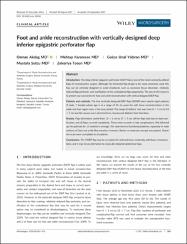| dc.contributor.author | Akdağ, Osman | |
| dc.contributor.author | Karameşe, Mehtap | |
| dc.contributor.author | Yıldıran, Gökçe Ünal | |
| dc.contributor.author | Sütçü, Mustafa | |
| dc.contributor.author | Tosun, Zekeriya | |
| dc.date.accessioned | 10.07.201910:49:13 | |
| dc.date.accessioned | 2019-07-10T19:50:39Z | |
| dc.date.available | 10.07.201910:49:13 | |
| dc.date.available | 2019-07-10T19:50:39Z | |
| dc.date.issued | 2018 | en_US |
| dc.identifier.citation | Akdağ, O., Karameşe, M., Yıldıran, G. Ü., Sütçü, M. ve Tosun, Z. (2018). Foot and ankle reconstruction with vertically designed deep inferior epigastric perforator flap. Microsurgery, 38(4), 369-374. https://dx.doi.org/10.1002/micr.30250 | en_US |
| dc.identifier.issn | 0738-1085 | |
| dc.identifier.issn | 1098-2752 | |
| dc.identifier.uri | https://dx.doi.org/10.1002/micr.30250 | |
| dc.identifier.uri | https://hdl.handle.net/20.500.12511/2041 | |
| dc.description | WOS: 000434152500003 | en_US |
| dc.description | PubMed ID: 28972286 | en_US |
| dc.description.abstract | IntroductionThe deep inferior epigastric perforator (DIEP) flap is one of the most commonly utilized flaps of reconstructive surgery. Although the horizontal flap design is the most commonly used, this flap can be vertically designed to avoid drawbacks such as excessive tissue dissection, relatively reduced flap perfusion, and scarification of the contralateral flap opportunity. The aim of this report is to present our case series for foot and ankle reconstruction with vertical designed DIEP flap. Patients and methodsThe free vertically designed DIEP flaps (VDIEP) were used in eight patients (7 male, 1 female) whose age is in a range of 20-66 years for soft tissue reconstructions in the ankle and foot region over a five-year period. The range of defects' size was from 8 x 5 cm to 15 x 7 cm and the causes were electrical burn, trauma and diabetic foot infections. ResultsFlap dimensions varied from 10 x 6 cm to 17 x 9 cm. All the flaps had two or more perforators, and all flaps survived completely. There were no early or late complications. We followed up the patients for 10 months in average. We observed no functional problems, especially in main motions of foot and ankle like eversion, inversion, flexion or extension except one patient. Donor site scars were acceptable in all patients. ConclusionsThe VDIEP flap may be an option for selected lower extremity soft tissue reconstructions, and it may be an alternative to classically designed abdominal flaps. | en_US |
| dc.language.iso | eng | en_US |
| dc.publisher | Wiley | en_US |
| dc.rights | info:eu-repo/semantics/openAccess | en_US |
| dc.subject | Mammaplasty | en_US |
| dc.subject | Perforator Flap | en_US |
| dc.subject | Epigastric Perforator | en_US |
| dc.title | Foot and ankle reconstruction with vertically designed deep inferior epigastric perforator flap | en_US |
| dc.type | article | en_US |
| dc.relation.ispartof | Microsurgery | en_US |
| dc.department | İstanbul Medipol Üniversitesi, Tıp Fakültesi, Cerrahi Tıp Bilimleri Bölümü, Plastik, Rekonstrüktif ve Estetik Cerrahi Ana Bilim Dalı | en_US |
| dc.authorid | 0000-0001-5106-0159 | en_US |
| dc.identifier.volume | 38 | en_US |
| dc.identifier.issue | 4 | en_US |
| dc.identifier.startpage | 369 | en_US |
| dc.identifier.endpage | 374 | en_US |
| dc.relation.publicationcategory | Makale - Uluslararası Hakemli Dergi - Kurum Öğretim Elemanı | en_US |
| dc.identifier.doi | 10.1002/micr.30250 | en_US |
| dc.identifier.wosquality | Q3 | en_US |
| dc.identifier.scopusquality | Q1 | en_US |


















